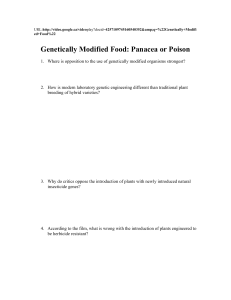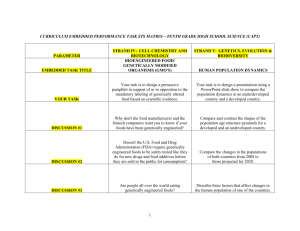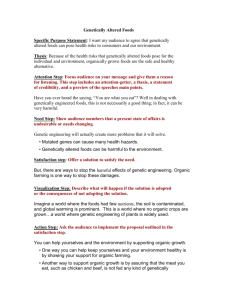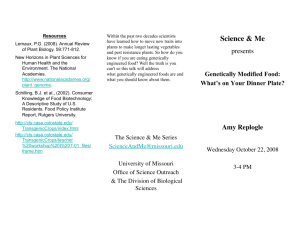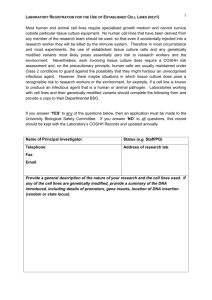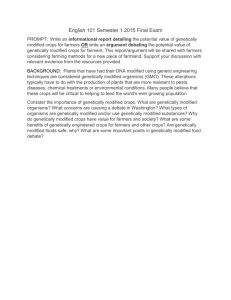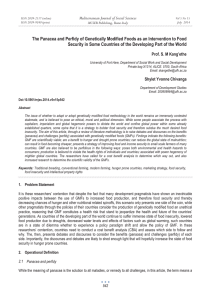Ashley Rowe
advertisement
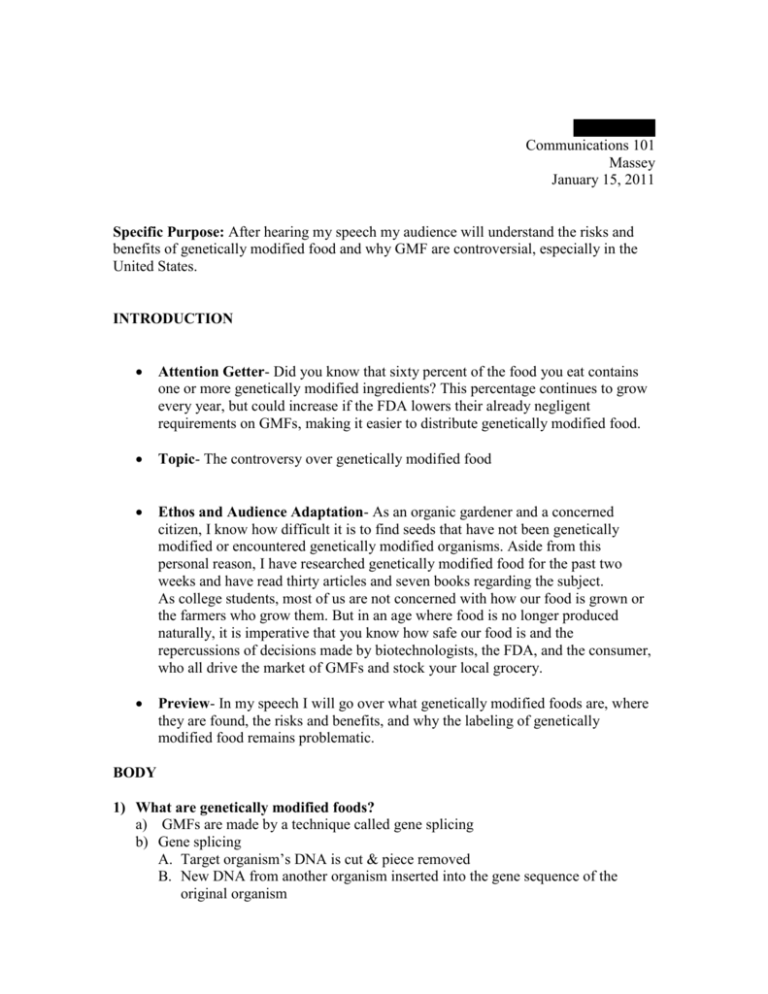
Ashley Rowe Communications 101 Massey January 15, 2011 Specific Purpose: After hearing my speech my audience will understand the risks and benefits of genetically modified food and why GMF are controversial, especially in the United States. INTRODUCTION Attention Getter- Did you know that sixty percent of the food you eat contains one or more genetically modified ingredients? This percentage continues to grow every year, but could increase if the FDA lowers their already negligent requirements on GMFs, making it easier to distribute genetically modified food. Topic- The controversy over genetically modified food Ethos and Audience Adaptation- As an organic gardener and a concerned citizen, I know how difficult it is to find seeds that have not been genetically modified or encountered genetically modified organisms. Aside from this personal reason, I have researched genetically modified food for the past two weeks and have read thirty articles and seven books regarding the subject. As college students, most of us are not concerned with how our food is grown or the farmers who grow them. But in an age where food is no longer produced naturally, it is imperative that you know how safe our food is and the repercussions of decisions made by biotechnologists, the FDA, and the consumer, who all drive the market of GMFs and stock your local grocery. Preview- In my speech I will go over what genetically modified foods are, where they are found, the risks and benefits, and why the labeling of genetically modified food remains problematic. BODY 1) What are genetically modified foods? a) GMFs are made by a technique called gene splicing b) Gene splicing A. Target organism’s DNA is cut & piece removed B. New DNA from another organism inserted into the gene sequence of the original organism c) Why GMFs are made A. Higher yields B. Less susceptible to disease, drought, and pests C. Better nutrition a) EG: pigs with growth hormone 30% less fat(McHughen) D. More economical a) Use less pesticides which saves farmers money E. Some are modified to take less time to grow and mature F. In industrialized nations, they are usually made for a better taste Transition: Now that I have explained how and why genetically modified foods are made, I will now discuss where these foods are found. 2. Where genetically modified foods are found A. 2006, 353 million acres of GMF crops in 22 countries (U.S. Dept. of Energy) B. Majority of GMFs come from the United States C. Common are soy beans, corn, and canola (Wholesome Goodness Productions) D. Genetically engineered animals found mainly in U.S. E. Examples include: a) Salmon that quickly mature F. Washington State apple growers have genetically modified apples a) First of their kind in Washington Transition: I have now gone over where GMFs are found, we will now be covering the benefits and risks of GMFs. 3. Arguments for the growth and cultivation of genetically modified foods A. Those who support GMFs: agricultural businesses, bioengineering specialists, and farmers who grow these crops B. Their main arguments are: a) Better taste b) More nutrients c) Possibility of less fat and leaner meat C. Better for the environment due to built-in herbicides (U.S. Department of Energy) d) Allows farmers to spray crops with weed killer without killing crops e) Important because 12% of crops grown are destroyed by weeds (Thomson) C. Providing food for poor countries D. Health for poor countries a) Some foods that could help poor countries: I. Golden rice (Vitamin A)- can prevent night blindness in children and other vision problems (Wholesome Goodness Productions) II. Peaches and apples that can provide immunizations to poor countries Translation: While these benefits are very compelling, one must also weigh the consequences when deciding whether growing and raising GMFs are worth the consequences mentioned below. 4. Arguments against the growing and raising of genetically modified food a) Damaging to the food web A. Destroying beneficial pollinators B. Experiment conducted in 1994 a) Monarch butterfly larvae ate milkweed dusted w/ GMF corn pollen b) Pollen was toxic- death rate of 44% (Letourneau and Burrows) b) Gene drift A. Process of genes from genetically modified crops and animals that enter the DNA of another non-modified organisms B. Crops- genes escaping via spillage of seeds (McHughen) C. Possibility of gene drift to other plants a) creation of super weeds b) hybrid plants- genetically modified plants mixing with wild relatives via cross pollination c) Allergens A. New DNA can cause allergic reactions B. Testing for allergens involves taking sample and testing it in a database C. Problem if new components aren’t in database d) Ethical questions in terms of animal gene manipulation A. Causing pain and discomfort to the animal is considered an inappropriate use of genetic manipulation a) EG: Beltville pigs were inserted with human growth hormones which caused severe arthritis, spinal deformities, and blindness (Nottingham) e) Seed companies creating a monopoly over selling genetically modified seeds A. Monsanto is the world’s largest genetically modified seed distributor B. Patents are also a problem, because many companies who create GM seeds get patents a) EG: Monsanto owns 11,000 patents (Garcia) C. Monsanto seeds have terminator genes, which are genes that prevent the seed from being saved because they prevent them from growing for more than one season ( Lambrecht) D. Thus through patents and terminator genes, farmers are forced to buy more seeds from Monsanto Translation: With that said, my last area of discussion is that of labeling genetically modified food, which isn’t as simple as most people think. 5. The problems of labeling genetically modified food a) The FDA does not require genetically modified food to be labeled A. GMFs receive the same considerations as other foods because they are the same (U.S. Food and Drug Administration) B. Only time they must be labeled is if they contain an allergen or have a different nutritional profile b) Labeling GMfs would cost more money in exports A. Segregating genetically modified and non-genetically modified foods would cost money in exports B. Countries, such as Britain, require all foods to be labeled as such (Marchant, Gardineau, Redick) c) General public doesn’t know enough information about genetically modified foods to make an informed decision A. Some people consider GMFs as “frankenfoods” B. Difficult if multiple ingredients are modified (McHughen) C. If they are to be labeled, the population must be informed CONCLUSION o Signal- While genetically modified food is a complicated topic to understand, it is our job as citizens to decide whether to allow the FDA to make this important decision for us. Obviously, there are multiple perspectives that must be considered and the repercussions of each. o Summary- In this speech I have explained how genetically modified foods are made, where they are found, the risks and benefits, and the problems of trying to label genetically modified food. o Closing- I hope now with this information that you are able to make an informed decision about where you stand on this controversial and important issue. Works Cited Garcia, Deborah. The Future of Food. Film “Genetically Modified Foods and Organisms”. Human Genome Project Information. U.S. Dept. of Energy. Web. Retrieved 7 Jan 2011 from <http://www.ornl.gov/sci/techresources/Human_Genome/elsi/gmfoods.html> Lambrecht, Bill. Dinner at the New Gene Café. New York: St. Martin’s Press, 2001. Print Letourneau, Burrows. “Genetically Engineered Organisms: Assessing Environmental and Human Health Effect”. CRC Press, 2002. Print. Marchant, Gardineau , Redick. Thwarting Consumer Choice: The Case Against Mandatory Labeling of GMFs. Washington DC: AEI Press, 2010. Print McHughen, Alan. Pandora’s Picnic Basket- The Potential Hazards of Genetically Modified Foods. Oxford University Press, 2000. Print. Nottingham, Stephen. Eat Your Genes: How Genetically Modified Food is Entering Our Diet. New York: Zed Books, 1998. Print. Thomson, Jennifer. Seeds for the Future: the Impact of GM Crops on the Environment. Ithaca, NY: Comstock Publishing Associates, 2006. Print United States Food and Drug Administration. Genetically Engineered Foods. 1999. Web. Retrieved 13 Jan 2011 from <http://www.fda.gov/newevents/testimony/ucm115032.htm> Wholesome Goodness Productions. Fed Up. Film
